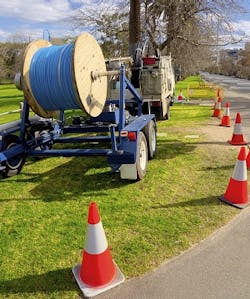7 tips and tricks to extend your cable’s life
As noted in a recent blog by cable and optical fiber giant Nexans: "It’s no exaggeration to say that today’s advanced high-quality cabling and connectivity solutions bring energy to life, facilitating energy transition and the exponential growth of data in countless industries and applications here in North America and around the globe. However, even the most high-tech cables need to be properly taken care of to support industrial applications, avoid costly downtime and safety issues and remain in efficient and exceptional working order for years and decades."
Here are seven helpful tips and tricks from Nexans to make sure your cable does just that:
1. Handle cable reels properly to avoid damage
"It’s important that large wire and cable reels are always securely loaded and stored upright on their flanges and block, hoisted with a properly secured shaft, and lowered from a truck using a hydraulic gate, hoist or fork lift. Careless loading and unloading of reels could lead to damage."
2. Ensure your cables are packaged until installation
"Wires and cables must be packaged to allow for safe, damage-free transport, storage and installation. An important part of this involves selecting the correct drum diameter with a minimum bending radius when rewinding on the reel to prevent overbending and damage."
3. Conduit layouts should be designed strategically
"Make sure conduit layouts are designed so that bends are concentrated near the end the cable is pulled from and minimized to lower pulling tensions. In some cases, the pulling tension from alternative pulling directions should be calculated and, where high pulling tensions are calculated, it may be necessary to consider using two or more pulls and possibly cable splicing."
4. Avoid friction whenever possible
"Use caution to ensure that your installation prep eliminates dragging cables across rough surfaces or sharp edges – laying the cable into place is always preferred. To reduce friction as much as possible, use a good quality pulling lubricant when pulling cable into a raceway (a.k.a. conduit)."
5. Be conscious of the installation environment’s temperature
"Select cables with a low temperature marking (e.g. -40°C) when installation in ambient temperatures is likely to be lower than -10°C, for example, in a warehouse freezer. When handling and installing cable in temperatures lower than -10°C, make sure to minimize flexing the conductor. If you need to flex the conductor, bend the conductor slowly, and use an increased minimum bend radius. Experts recommend that you keep the cable in a warm environment (warmer than 15°C for at least 24 hours) prior to installation. And to minimize damage, installation should take place on the same day the cable is removed from the warm environment."
6. Learn the cable codes for extreme situations
"Choose cables marked 'HL' for installation and use in hazardous locations and 'SR', 'SUN RES', or 'SUNLIGHT RESISTANT' when exposure to direct sunlight is likely. Also, remember to select cables intended for vertical installations when installing them in long, vertical locations like elevator shafts, tall buildings and grain elevators."
7. Always follow the manufacturer’s recommendation for care and handling.
"This is the most important tip to remember. If you have any questions or concerns regarding cable selection and installation, reach out to whom you bought your cable from (your installer, customer representative, or the wire and cable distributor) – they’re likely to have the most up-to-date information you’re looking for."
Nexans S.A. is a global leader in the cable and optical fiber industry headquartered in Paris, France. Per Wikipedia, as the world's second largest manufacturer of cables after Prysmian S.p.A., Nexans is active in four main business segments: buildings and territories (construction, local infrastructure, smart cities / grids, e-mobility); high voltage and projects (offshore wind farms, subsea interconnections, land high voltage); data and telecoms (telecom networks, data transmission, FTTx, LAN cabling, hyperscale data center solutions); and industrial (renewable energies, petroleum, railways and rolling stock, aeronautical and automation).
Related: General Cable fielded takeover bids from Prysmian, Nexans, NKT
